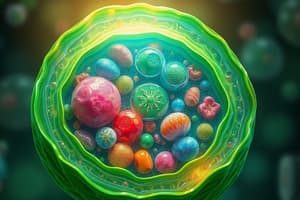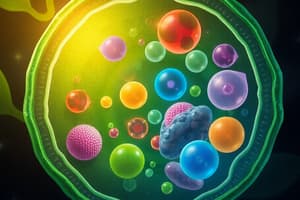Podcast
Questions and Answers
What is a primary function of water in living organisms?
What is a primary function of water in living organisms?
- It provides a source of energy.
- It functions solely as a waste product.
- It serves as a storage medium for nutrients.
- It is involved in metabolic reactions and plant growth. (correct)
What characterizes a suspension?
What characterizes a suspension?
- Particles are less than 1 nm in size.
- Particles remain indefinitely dispersed without settling.
- Particles settle down at the bottom of the container over time. (correct)
- Particles are uniformly distributed.
How do colloidal solutions differ from suspensions?
How do colloidal solutions differ from suspensions?
- Colloids contain particles larger than 100 nm.
- Colloids are homogeneous mixtures.
- Colloids can pass through semipermeable membranes.
- Colloids are stable and do not settle out. (correct)
What is a typical example of a colloidal solution?
What is a typical example of a colloidal solution?
Why do colloidal particles carry electric charges?
Why do colloidal particles carry electric charges?
What property allows colloidal particles to remain dispersed in a solution?
What property allows colloidal particles to remain dispersed in a solution?
Which of the following does NOT describe a property of colloidal solutions?
Which of the following does NOT describe a property of colloidal solutions?
Which of the following examples illustrates a suspension?
Which of the following examples illustrates a suspension?
What characterizes lyophilic colloids?
What characterizes lyophilic colloids?
Which property differentiates hydrophobic colloids from hydrophilic colloids?
Which property differentiates hydrophobic colloids from hydrophilic colloids?
What do colloid stabilizers do?
What do colloid stabilizers do?
Which of the following correctly describes the stability of hydrophilic colloids?
Which of the following correctly describes the stability of hydrophilic colloids?
Which statement is true regarding the surface tension of hydrophilic and hydrophobic colloids?
Which statement is true regarding the surface tension of hydrophilic and hydrophobic colloids?
What is protoplasm primarily composed of?
What is protoplasm primarily composed of?
Which type of solution is characterized by having particles less than 1 nm and does not settle down?
Which type of solution is characterized by having particles less than 1 nm and does not settle down?
Which of the following is an example of a non-electrolyte?
Which of the following is an example of a non-electrolyte?
What is one of the primary roles of water in plant cells?
What is one of the primary roles of water in plant cells?
Which statement about colloidal systems is true?
Which statement about colloidal systems is true?
What distinguishes a heterogeneous mixture from a homogeneous mixture?
What distinguishes a heterogeneous mixture from a homogeneous mixture?
Which of the following correctly describes the components found in a true solution?
Which of the following correctly describes the components found in a true solution?
In what form is most of the protoplasm characterized?
In what form is most of the protoplasm characterized?
Flashcards
Protoplasm
Protoplasm
The living substance of a cell, encompassing both the nucleus and cytoplasm.
Solution
Solution
A mixture where components are evenly distributed and mixed throughout.
Colloidal Solution
Colloidal Solution
A type of mixture where particles are larger than 1 nm but small enough to remain suspended.
Electrolyte Solution
Electrolyte Solution
Signup and view all the flashcards
Non-Electrolyte Solution
Non-Electrolyte Solution
Signup and view all the flashcards
True Solution
True Solution
Signup and view all the flashcards
Solute
Solute
Signup and view all the flashcards
Solvent
Solvent
Signup and view all the flashcards
Lyophilic Colloids
Lyophilic Colloids
Signup and view all the flashcards
Lyophobic Colloids
Lyophobic Colloids
Signup and view all the flashcards
Colloid Stabilizers
Colloid Stabilizers
Signup and view all the flashcards
Water film in Lyophilic Colloids
Water film in Lyophilic Colloids
Signup and view all the flashcards
Electric Charge Shell in Colloids
Electric Charge Shell in Colloids
Signup and view all the flashcards
What is a suspension?
What is a suspension?
Signup and view all the flashcards
What is a colloid?
What is a colloid?
Signup and view all the flashcards
What is the dispersion medium in a colloid?
What is the dispersion medium in a colloid?
Signup and view all the flashcards
What is the dispersed phase in a colloid?
What is the dispersed phase in a colloid?
Signup and view all the flashcards
What are electrical properties of colloidal particles?
What are electrical properties of colloidal particles?
Signup and view all the flashcards
What are the important roles of water in a cell?
What are the important roles of water in a cell?
Signup and view all the flashcards
What is turgidity in a cell?
What is turgidity in a cell?
Signup and view all the flashcards
What is cell elongation?
What is cell elongation?
Signup and view all the flashcards
Study Notes
Plant Cell Structure
- Plant cells are complex, containing various organelles
- Key organelles include: cell wall, cell membrane, endoplasmic reticulum, ribosomes, nucleus, nucleolus, vacuole, cytoplasm, golgi apparatus, golgi vesicles, mitochondria, and chloroplasts
- The cell wall provides support and structure
- The cell membrane controls what enters and leaves the cell
- Ribosomes are responsible for protein synthesis
- The nucleus contains the cell's genetic material
- The nucleolus is involved in ribosome production
- The vacuole maintains cell pressure
- The cytoplasm is the jelly-like substance filling the cell
- The golgi apparatus modifies and packages proteins
- Golgi vesicles transport proteins
- Mitochondria produce energy
- Chloroplasts carry out photosynthesis
The Protoplasm
- Protoplasm is the living substance of the cell (nucleus and cytoplasm)
- It is a colorless, jelly-like substance
- It contains food elements like proteins, fats, carbohydrates, minerals, and water
The Protoplasm (Colloidal System)
- Protoplasm is a colloidal complex with properties of a colloidal system
- Its colloidal properties are due to large, complex protein, carbohydrates, and fat molecules—which approach colloidal dimension
- The colloidal system is an essential aspect of living matter
Solutions
- Solutions are homogenous mixtures of molecules evenly distributed
- Everything in a solution is spread out and mixed evenly
- Heterogeneous mixtures have varying concentrations in different parts
Types of Solutions
- True solutions have solute particles smaller than 1 nm, stable, and remain evenly dispersed
- Examples include salt or sucrose in water
- Solute particles are individual molecules or ions
- Colloidal solutions have particles with sizes between 1 and 100 nm
- They remain dispersed, forming a two-phase system (liquid dispersion phase and solid dispersed phase)
- Colloidal particles are clumps or clusters of molecules
- Examples include starch in water or egg albumin
- Colloidal particles pass through filter paper but not semipermeable membranes
- Suspensions have particles larger than 100 nm
- Particle sizes are large enough to be seen with a naked eye
- They're unstable; the particles settle out over time, separating from the liquid layer
- Examples include chalk in water
1- True Solutions
- Consist of a homogenous mixture of at least two components (solute dissolved in a solvent)
- Solute particles (size) are smaller than 1 nm
- The solute remains evenly dispersed and stable (doesn't settle)
- Example: sugar dissolved in water
1- True Solutions (Electrolytes and Non-electrolytes)
- Electrolytes: ionic substances that dissolve in water and conduct electricity (ex. salt)
- Non-electrolytes: non-ionic substances (ex. sucrose)
Water in Plant Cells
- Water is the major solvent in plant cells
- It's crucial for various cellular functions, including transporting nutrients, supporting metabolic reactions, contributing to cell turgidity, and aiding cell elongation
2- Suspension
- Suspension is a heterogeneous mixture where particles larger than 100 nm are dispersed in a liquid but not dissolved
- The particles are not separated into molecules but rather form aggregates of molecules that can be seen with the naked eye
- It's an unstable system; the particles gradually settle
3- Colloidal Solutions
- A heterogeneous mixture where particles (1–100 nm) remain dispersed throughout a medium in a stable manner
- Colloidal particles are clusters of molecules and are in the form of clusters of molecules
- Colloids easily pass through filter paper but not semipermeable membranes
Colloidal Properties of Particles
- Colloidal particles carry electric charges (positive or negative)
- The charge is consistent for a given system
- The charges are due to adsorption of free ions in the medium
- The preferential adsorption of positive ions leads to a positive charge for the particle
Types of Colloids
- Lyophilic colloids (Hydrophilic colloids): liquid-loving
- Formed from dispersed particles surrounded by a water shell and electric charge
- They are stable and not readily precipitated, easily precipitated by dehydration and neutralization
- Lyophobic colloids (Hydrophobic colloids): liquid-hating
- Formed from dispersed particles surrounded only by an electric charge
- They have similarly low surface tension and viscosity to the solvent
- They are less stable and easily precipitated by neutral salts
Colloid Stabilizers
- Substances added to increase the stability of a colloid and prevent its precipitation
- Examples include gums and proteins
- Stabilizers form a protective layer around the colloidal particles
Studying That Suits You
Use AI to generate personalized quizzes and flashcards to suit your learning preferences.




